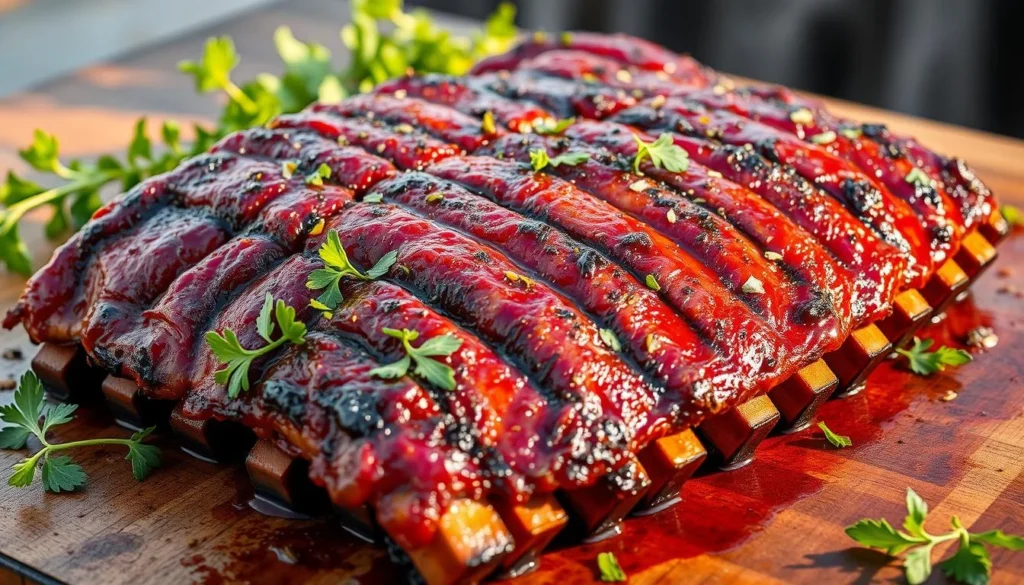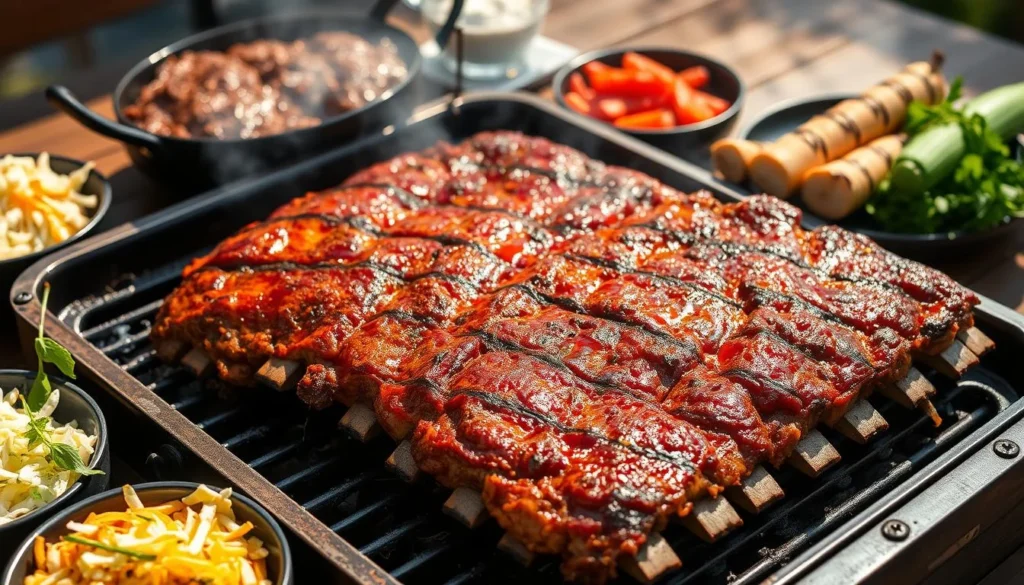Grilling beef ribs, whether BBQ or smoked, requires the right techniques and ingredients. This ensures tender and flavorful results. Whether you’re an experienced griller or new to it, knowing the basics is key to making delicious dishes.
Every step, from marinades to grilling times, matters when preparing beef ribs. A rack of beef back ribs weighs about 4 pounds and has around 10 ribs. It’s important to plan and consider serving sizes, about 1.5 pounds per adult. By using expert techniques and quality ingredients, you can make perfectly grilled beef ribs every time.
Table of Contents
Understanding Grilled Beef Ribs
Grilled beef ribs are a tasty treat. To make them tender and delicious, you need to know the basics. Beef ribs are a favorite cut, great for grilling, braising, or roasting. Choosing the right type and preparing them correctly is key.
A rack of beef ribs feeds 4-5 people, with 8 ribs in it. For tender and flavorful ribs, cook them at 225°F to 250°F. This slow cooking breaks down the meat, making it tender and juicy.
What Are Beef Ribs?
Beef ribs come in two types: short ribs and back ribs. Short ribs are meatier and fattier. Back ribs are leaner and sweeter. Knowing the difference helps you pick the right ribs for your dish.
Types of Beef Ribs
Beef ribs include short ribs and back ribs. Short ribs have subtypes like Plate, Chuck, English-Cut, and Flanken-Cut. Back ribs are from the rib section, tender and slightly sweet.
Key Characteristics of Quality Ribs
Quality ribs have marbling, which means they’re tender and flavorful. Cooking time and temperature vary by rib type and thickness. For example, 1″ thick ribs need about 4 hours at 205°F – 210°F.
Learning about grilled beef ribs helps you make a great meal. Whether you want an easy or the best recipe, choosing the right ribs and cooking them right is essential.
Essential Tools for Grilling Beef Ribs
To get tender beef ribs, you need the right tools. A good grill is key, providing the heat and space for your ribs. A reliable thermometer is also essential for controlling the temperature.
Other important tools include heat-resistant gloves, meat claws, and a chimney starter. These help make grilling safer and more efficient. For example, gloves protect your hands from heat, and meat claws make handling meat easier. A chimney starter lights charcoal quickly and evenly.
A digital thermometer is vital for checking meat temperatures. This ensures your beef ribs are cooked just right. Smoke tubes add flavor, and a log book helps track your grilling progress.
Must-Have Grilling Equipment
- Good quality grill
- Reliable thermometer
- Heat-resistant gloves
- Meat claws
- Chimney starter
- Digital thermometer
- Smoke tubes
- Pen and paper log book
With these tools, you’ll be on your way to making delicious beef ribs. Your friends and family will love them.
Best Cuts for Grilled Beef Ribs
Choosing the right cut of meat is key for grilled beef ribs. You can pick between short ribs or back ribs. Short ribs are meatier and fattier, making them tender and flavorful. Back ribs are leaner, perfect for those who prefer less fat.
Decide between bone-in and boneless ribs based on your taste and cooking style. Bone-in ribs are more flavorful, but boneless ribs are easier to cook and serve. It’s also important to get quality meat for tender and flavorful ribs.
Short Ribs vs. Back Ribs
Here’s a comparison of short ribs and back ribs:
- Short ribs: meatier, higher fat content, more tender and flavorful
- Back ribs: leaner, less fat, better option for those looking for a leaner cut of meat
Choosing Bone-In vs. Boneless
Bone-in ribs and boneless ribs have their own pros and cons. Bone-in ribs are more flavorful, but boneless ribs are easier to cook and serve.
Sourcing Quality Meat
Getting quality meat is key for great grilled beef ribs. Look for reputable butchers or meat suppliers for the best meat.
| Type of Ribs | Characteristics | Cooking Method |
|---|---|---|
| Short Ribs | Meatier, higher fat content | Grilled, smoked, or braised |
| Back Ribs | Leaner, less fat | Grilled, smoked, or roasted |
Preparing Your Beef Ribs
To get the best beef ribs recipe, start by preparing your ribs right. Trim off excess fat, remove the membrane, and season with your favorite spices and herbs. Trimming fat prevents flare-ups and ensures even cooking, making your ribs tender and enjoyable.
Removing the membrane, or pleura, tenderizes the meat and improves texture. Use a paper towel to grip the membrane for easy removal. Then, season your ribs with a dry rub or marinade to add flavor and enhance taste.
- Trimming excess fat to prevent flare-ups and ensure even cooking
- Removing the membrane to tenderize the meat and improve texture
- Seasoning the ribs with a dry rub or marinade to add flavor and enhance the overall taste
By following these steps, you’ll make delicious, easy beef ribs that will wow your guests. Whether you’re using a top recipe or trying new flavors, proper preparation is essential for tender, flavorful ribs.
Marinades for Flavorful Grilled Ribs
To get tender beef ribs, marinate them in a mix of ingredients. This mix boosts their flavor and texture. A great marinade can make your beef ribs unforgettable.
For the best results, marinate your ribs in the fridge for at least 24 hours. This lets the flavors soak deep into the meat. Your ribs will be tender and juicy. Some marinades work best just before grilling, while others need hours or even overnight.
- Marinade duration: 24 hours for optimal results
- Recommended marination time for tenderness: 2-6 hours
- Ideal cooking temperature range for Texas-style ribs: 225-250°F
By following these tips and using the right marinade, you can make delicious beef ribs. They will impress everyone. Whether you like classic or unique marinades, the goal is to find the perfect flavor mix for your grilled ribs.
The Perfect Grilling Techniques
Grilling grilled beef ribs right is key to getting them tender and tasty. You can grill them directly over the heat or away from it. Direct grilling puts the ribs right over the flames, while indirect grilling keeps them a bit further away.
For BBQ beef ribs, the right temperature depends on your grill and how done you like them. Cooking times change based on the meat’s thickness and how done you want it. Thicker cuts need longer, while thinner ones cook faster.
Cooking Methods
Some top ways to cook smoked beef ribs include:
- Low and slow cooking: This method cooks the ribs at a low heat for a long time. It makes the meat tender and full of flavor.
- Wrap and rest: This method wraps the ribs in foil and lets them rest. It helps the meat soak up flavors and get tender.

By using these techniques, you can grill grilled beef ribs that will wow your guests.
| Cut of Meat | Cooking Time | Temperature |
|---|---|---|
| Baby back ribs | 1-2 hours | 180-195°F |
| Spare ribs | 1.5-2.5 hours | 180-195°F |
| Short ribs | 2-3 hours | 145°F |
Wood and Charcoal Flavor Combinations
Grilling marinated beef ribs can be greatly influenced by the wood and charcoal used. For the best results, try hickory, oak, or mesquite wood. Each wood type brings a unique taste to your ribs. Hickory adds a strong, sweet flavor, while oak offers a milder, smokier taste. Mesquite gives a bold, earthy flavor.
For easy beef ribs, many prefer lump charcoal for its consistent heat. Briquettes are also an option, being more affordable. It’s important to experiment with different combinations to find the perfect flavor for your ribs.
Best Wood Choices for Beef Ribs
- Hickory: Strong, sweet flavor
- Oak: Mild, smoky flavor
- Mesquite: Bold, earthy flavor
Lump Charcoal vs. Briquettes
Lump charcoal offers consistent, high heat. Briquettes, on the other hand, are more affordable. Think about the pros and cons of each when choosing for your easy beef ribs recipe.
| Charcoal Type | Heat | Cost |
|---|---|---|
| Lump Charcoal | High, consistent | More expensive |
| Briquettes | Lower, less consistent | Less expensive |
Side Dishes to Complement Grilled Beef Ribs
When serving tender beef ribs, the right side dishes make a big difference. Try pairing your savory beef ribs with coleslaw, baked beans, or corn on the cob. These classic BBQ sides add a comforting touch to the rich flavor of your grilled meat ribs.
For a lighter option, consider a salad or salsa with your ribs. The acidity and crunch of these dishes balance the meat’s richness. Here are some favorites:
- Coleslaw with shredded cabbage and tangy dressing
- Grilled or roasted veggies like asparagus or bell peppers
- Fresh salsa or pico de gallo with diced tomatoes and herbs

Choosing the right side dishes is all about matching flavors and textures with your grilled meat ribs. A bit of creativity can turn a meal into a memorable experience. Your guests will be sure to ask for more.
Serving Suggestions for Grilled Beef Ribs
When serving grilled beef ribs, how you present them matters a lot. You want to impress your guests. A well-presented dish can make the meal better.
Try serving your BBQ beef ribs with sides like coleslaw, baked beans, or grilled corn. These classic choices will match the ribs’ rich flavors. They make a complete meal.
For something different, pair your smoked beef ribs with sides like cucumber salad or pasta salad. The cool, crunchy textures contrast nicely with the tender ribs. Don’t forget a cold beer or sweet tea to drink.
Leftover grilled beef ribs can be stored in an airtight container in the fridge for up to three days. To reheat, wrap them in foil and bake at 300°F (150°C) for 20-25 minutes. This way, you can enjoy your BBQ beef ribs for days.
Troubleshooting Common Grilling Issues
Even the most skilled grillers can run into problems when making marinated beef ribs. But, with the right methods, you can beat these issues and always get great results.
Dealing with Tough Ribs
If your beef ribs turn out tough, don’t worry. Marinating them for 24 hours can make them tender. You can also try braising them before grilling or using a meat tenderizer.
Preventing Overcooking
Overcooked ribs can be dry and tough. Keep an eye on the temperature and take them off the grill at 145°F. Letting the ribs rest for 10-20 minutes before serving helps keep them moist.
Adjusting for Weather Conditions
Weather like wind, rain, and changing temperatures can affect grilling. Use a dome-style grill or adjust cooking times and temperatures as needed. Keeping the heat steady is essential for perfect ribs, no matter the weather.
By tackling these common grilling problems, you’ll get better at grilling beef ribs. You’ll impress everyone with your delicious meals every time.

